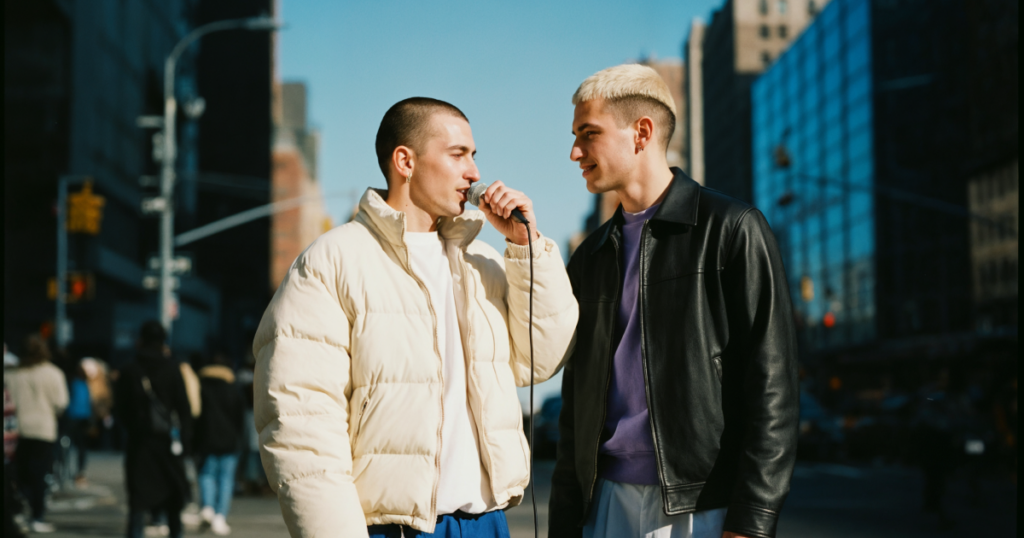Social media has irrevocably changed a lot of things about our world — and a comedy career trajectory is one of them. One video going viral can change a performer’s life overnight. Platforms like TikTok, Instagram (particularly Reels), and microblogging platforms like X (Twitter), Threads, or Bluesky are the new stages for comedians, reshaping how audiences engage with material, and how new talent is discovered and shared.
All the world’s a stage when the whole world has access to your work in their pocket. Social media is now one of the most prominent players in determining success. Here’s how that happened and how today’s comedians can adapt.
The Evolution of the Comedian

As technology evolves, so do the paths to success for every field, and not even the funny people are safe from this inevitability.
The old way
The historical path to success for comedians meant starting with open mic nights, working your way up to and through the comedy club circuit, and then — if you’re lucky — a big break in the form of a TV special or recurring role on a show like Saturday Night Live.
The gatekeepers in this system were club owners, managers and agents, festival and network executives, and specific late-night TV hosts who could make your career (for the youngest in the room, you can look up a man named “Johnny Carson”).
Patton Oswalt wrote about the breakdown of this system for his keynote at Montreal’s Just for Laughs comedy festival back in 2012:
“We can just walk away.
You know why we can do that now? Because of these. (Oswalt holds up an iPhone) In my hand right now I’m holding more filmmaking technology than Orsen Welles had when he filmed Citizen Kane.
I’m holding almost the same amount of cinematography, post-editing, sound editing, and broadcast capabilities as you have at your TV network.”
He’s talking about comedians having more agency in their career trajectory, being able to put their work out for the masses to decide for themselves what’s good instead of letting a select few gatekeepers decide.
The new way
Things have evolved since 2012, of course. Social media isn’t a democracy — social platforms run on a series of increasingly mysterious algorithms creators have to work to please, sacrificing their time and creativity to new a kind of unseen god.
Some algorithmic secrets are discoverable through data-driven strategy, but the caveat is always that a creator must experiment to find the right balance for their specific audience. And audiences, annoyingly, evolve as platforms do.
Platform-specific comedy evolution:
- TikTok: On TikTok especially, we’ve seen short-form sketches grow from earlier iterations like Vine (RIP). At the same time, comedians used to performing for live audiences use the platform to promote their stand-up work with clips (some do both!).
- Instagram: Comedians on Instagram might repost their TikTok videos as Reels, tweaking content for this specific platform. They can also take advantage of static visual humor in their grid posts or on Stories, giving them another avenue for connecting with fans.
- Twitter/Bluesky/Threads: Microblogging platforms allow users to upload videos, but they shine in allowing users to post one-liners and observational humor to build a loyal audience while simultaneously networking and collaborating with fellow comedians.
- YouTube: They’ve introduced Shorts, but YouTube is better known for its longer-form videos and other types of video content like interviews, comedy specials, and collaborations that comedians can host on their channel and create playlists around.
Any of these platforms allow for discovery from audience members and the last remaining gatekeepers (who are likely to be fans themselves, as Oswalt predicted). Social media platforms allow for immediate audience feedback layered with longer-form, data-driven feedback in the form of engagement metrics.
Live audiences only allow for immediate feedback; you know if a joke killed or bombed instantly by the audience’s reaction. If you perform the same set again, you might get a different response because it’s a different audience on a different day with different contexts from their lives and the day’s events.
On social media, a single clip can get picked up weeks or months after going up and catch on with a different audience from the one that most closely follows a comedian’s work. Breaking follower containment can be for better or for worse, as anyone who has ever tasted virality knows. “Engagement” can mean people love what you posted, but it can also mean hateful comments that spiral into harassment as your work gets shared further with hostile audiences. That can still draw enough attention to grow your audience overall, but it can come with a hefty toll on your mental health. Online harassment isn’t just words when it threatens someone’s safety and well-being.
Every algorithm prizes engagement, though few have robust tools to limit harassment on a meaningful level when things go viral (some, like X, have reduced those tools). That means the new gatekeeper on any given platform is the algorithm — but the algorithm’s designers and the platform’s owner are the real gatekeepers.
The Evolution of Comedy

Like any other art form, comedy has trends that change along with societal preferences and technological advances. Vaudeville shows and knock-knock jokes were once the height of comedy, just as Vine shorts had their brief reign (which ironically live on in longer YouTube compilations).
Vine is a great case study for this: jokes had to be completed in 6 seconds from set-up to punchline, constraints making for incredible creativity or perfect for capturing an absurd moment. TikTok allows videos up to 10 minutes if filmed on the platform and up to an hour if uploaded. However, TikTok recommends videos be 21-34 seconds for maximum engagement.
This tracks with research around attention spans online; researchers found attention spans for digital tasks averaged 2.5 minutes back in 2004, dropping to 75 seconds in 2012, and to 47 seconds now. Task-switching (also known as multitasking) stresses us out, yet we keep switching from app to app in pursuit of that next dopamine hit. Comedians and creators keep pushing out content to score that same hit from the other side of the screen.
Visual elements have always been essential to comedy, from slapstick routines to stand-ups who use props and, more recently, creative choices in video style and editing. “Bad” editing, costuming and props, or poorly integrated backgrounds can be as impactful as smooth, stylized cuts depending on the subject and intended audience. Compare 2000s nostalgia accounts on Instagram to Zach King’s magic tricks, for example.
Comedy niches can grow from any platform, but different styles tend to take hold based on each platform’s constraints. Tumblr (yes, it’s still around) has a unique brand of absurdism that was difficult for most brands to capture, with the exception of Denny’s. Now every brand tries to copy a similar style of corporate shitposting that takes its inspiration from subcultures like Weird Twitter.
As with any new technology, established comedians had to figure out how to adapt. That means deciding how to present their existing material on social platforms as another marketing channel, using it to test new material and as a new way to connect with their existing audience while building a new one. It’s a lot to balance — even beloved household names haven’t always gotten it right.
Audience Engagement

In the example cited, Steve Martin explains the difference between live audience response and workshopping a joke on social media.
“Comedy is treacherous. I used to try out jokes in clubs and the audience’s feedback would tell me when I had crossed a line, or how to shape a joke so it is clear. Today, the process is faster. It’s your brain, a button, then millions of reactions. But it’s my job to know.”
Getting immediate feedback at scale is both a pro and a con; your core audience will likely respond positively, while something that breaks containment can go either way. The real challenge for a comedian is figuring out who their material resonates with, and whether that means their target audience’s content interests and platform preferences are shifting.
Comments sections can become a kind of comedy workshop where comedians can riff off one another, forging relationships that can lead to collaborations. Popular accounts will often plan collaborations, sometimes based on content trends and other times responding to one another’s work.
If two accounts have similar target audiences, this kind of collaboration can help boost the followings of both. Regularly interacting with tags, comments, and DMs can help cement audience loyalty (and comedians are wise to tap into automation solutions like Manychat to help simplify the process).
Comedy can be a grueling profession and almost always a side gig for those starting out. That makes the monetization options on social extremely appealing, like creating exclusive bonus content that feels “worth it” to subscribers on premium channel subscriptions or offering high-quality and on-brand merch. Otherwise, it feels like a money grab, and your reputation could take a hit.
The Business of Comedy on Social Media

Each platform has different options for monetization, and it’s up to every creator and comedian to decide if it’s worth investing heavily in a presence on a channel they don’t own. Algorithms can change at any time, as can terms of service. What worked yesterday could stop today or tomorrow, with no avenue for recourse. It’s a risk that many are willing to take.
Revenue streams by platform
Every platform also has the opportunity for brand partnerships, as a marketing channel for merch (even if there isn’t an option for direct selling), marketing for live shows and tours, and promoting things like podcast appearances or newsletters.
- TikTok offers a range of options for creators and comedians to make money, from their Creativity Program to TikTok Shops, an affiliate program, the ability to go live and receive virtual gifts, collect tips, and more.
- Instagram (and Facebook) have eligibility requirements for accounts to be able to monetize. On Instagram, you need to have a Creator account and meet the eligibility requirements. With that, you can tap into brand partnerships or affiliate programs, use Badges during livestreams, enable ads on Reels, turn on subscriptions, and earn milestone bonuses.
- YouTube has a YouTube Partner Program with specific policies that must be met for channels to be eligible. Once in the program, participants can earn money through ads, affiliate marketing, other influencer activity, content licensing, the YouTube Shorts Fund, using Super Chat and Super Stickers during livestreams, YouTube Premium revenue, and more.
On the microblogging platforms, X allows users to set up subscriptions, tips, and other options, but that should be weighed against the general brand risks associated with being active there. Threads is connected to other Meta products like Facebook and Instagram, making it easier to reach an existing audience in a slightly different format and promote your work through a different channel.
Bluesky is the newest entrant with the fewest features, and it will be interesting to see how it evolves. One feature it does have is the “starter pack,” which can blow up an account’s following overnight. Small accounts that get added to popular start packs — covering everything from astrophysics to comedy — can gain tens of thousands of followers. That can be great but also results in a fundamental shift in audience interactions from sheer volume to tone.
Other considerations
If you’re active across social platforms as a creator or comedian, you’re accountable to the same rule as a brand: You need to have a consistent cross-platform presence that’s tweaked for optimum performance in each place.
That gives you some security if one platform becomes untenable for any reason, along with helping build a loyal audience of fans. An established audience of loyal followers can help land representation in the digital age.
Challenges and Considerations for Creators and Comedians

There’s plenty for creators and comedians to consider before trying to launch a career on social. It’s no secret that everyone is constantly bombarded by a firehose of content across platforms. Audiences and algorithms are fickle, and trying to keep up with the latest trends can be exhausting.
It’s also a risk to build a huge, engaged following on a platform you don’t own and ultimately have no control over. What happens if it goes away? There’s no guarantee that the same audience will follow you to a new place.
Creators and comedians should also consider copyright and ownership issues, especially with the rise of AI. Read the terms of service of each platform carefully — X’s new ToS explicitly states they can use any content posted on the platform to train their AI.
The dream of going viral and taking off overnight may come with an impact on your mental health. Harassment, death threats, and doxxing are all serious and routine risks that popular creators have to deal with. Even without that pressure, creators often face burnout from an endlessly demanding algorithm and audiences that always want more.
There’s also the balance between creating authentic content that your audience craves and creating what the algorithm wants and will serve to more feeds, helping to grow your audience. Creating only for the former might stifle your account’s growth, while creating only for the latter might alienate the audience you already have.
Funny You Say That

The comedy club has grown to include the personal computer everyone carries around in their pockets, which means expanded opportunity alongside a new class of considerations for creators and comedians. The old gatekeepers are gone or have had their powers limited, while the new gatekeepers have grown up in the form of algorithms and those who control them.
Successful jokers have to walk the line between creating authentic comedy that resonates with their audience and capitalizing on enough trends to appease the algorithm gods — and that’s in addition to running social like a community-based marketing channel.
If Manychat can help, we’re always here (and we’ll laugh at your jokes).







